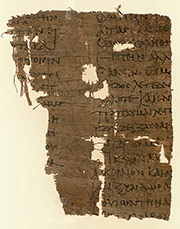Papyri
Papyrus Collection
With over 12,000 papyri and hundreds of texts on ostraca (potsherds), wood, wax tablets, parchment, and lead, dating from around 1,000 BCE to 1,000 CE, the University of Michigan Papyrus Collection is the largest research and teaching collection of its kind in North America.
Most of the papyri are in Greek (the lingua franca of the eastern Mediterranean after the conquests of Alexander the Great), but there are also many in Egyptian hieroglyphic, demotic, and Coptic, and some in Arabic and Latin. Its contents include fragments of works by classical authors, Christian texts, and scientific writings (astronomy, mathematics, medicine), but most of the papyri by far are public and private documents such as imperial decrees, administrative and taxation records, letters, accounts, wills, and marriage agreements.
A small number of papyri in the U-M Papyrus Collection are philosophical:
- A small second–third c. C.E. fragment of Plato’s Phædo
(P. Mich. inv. 5980) - A fragment of Aristotle’s Politica (P. Mich. inv. 6643)
- A fragment of logic in the Stoic tradition (P. Mich. inv. 2906)
The University of Michigan is one of the world’s prime centers to study any kind of papyrology. There are several faculty in the Department of Classical Studies who work with papyri.
Professor Richard Janko is one of the world’s leaders in the publication of Herculaneum papyri, a very important source for new philosophical works from antiquity.
Professor Francesca Schironi specializes, among others, in ancient (Alexandrian) scholarship and literary papyrology.
Professor Arthur Verhoogt, Acting Archivist of the Papyrus Collection, specializes in documentary papyri from the Ptolemaic and Roman periods.
In the Department of Near Eastern Studies, Professor Terry Wilfong specializes in Coptic papyrology.
In addition, a search is currently underway to fill a joint appointment in Classical Studies and the Library (Assistant/Associate Professor of Papyrology and Archivist of the Papyrus Collection).
The collection has an extensive website, with many details on its resources, exhibitions and events. For those new to the subject, don’t miss the excellent introductory surveys and pictures.



Follow the Program
in Ancient Philosophy